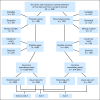Long-term disease-specific functioning among prostate cancer survivors and noncancer controls in the prostate, lung, colorectal, and ovarian cancer screening trial
- PMID: 22734029
- PMCID: PMC4166119
- DOI: 10.1200/JCO.2011.41.2767
Long-term disease-specific functioning among prostate cancer survivors and noncancer controls in the prostate, lung, colorectal, and ovarian cancer screening trial
Abstract
Purpose: Within the Prostate, Lung, Colorectal, and Ovarian Cancer Screening Trial (PLCO), we assessed the long-term disease-specific functioning among prostate cancer (PCa) survivors versus noncancer controls, the impact of trial arm (screening/usual care) on functioning, and the effect of treatment modality on functioning.
Patients and methods: PCa survivors (n = 529), 5 to 10 years postdiagnosis, were frequency-matched to noncancer controls (n = 514) for race, screening center, year of enrollment, and trial arm. Participants completed a telephone interview regarding PCa-specific symptomatology. Weights accounted for patient selection from the five PLCO screening centers. Propensity-score methods were used to balance groups of interest with respect to demographic and medical characteristics.
Results: Weighted linear regression analyses revealed poorer sexual and urinary function among PCa survivors compared with noncancer controls (P < .001). Trial arm was not significantly related to any outcome (P > .31). Compared with radical prostatectomy patients (n = 201), radiation-therapy patients (n = 110) reported better sexual (P < .05) and urinary (P < .001) functioning but poorer bowel outcomes (P < .05). Survivors who received treatment combinations including androgen deprivation (n = 207) reported significantly poorer hormone-related symptoms compared with radical prostatectomy patients (P < .05). CONCLUSION This study demonstrated the persistence of clinically significant, long-term PCa treatment-related sexual and urinary adverse effects up to 10 years postdiagnosis. To our knowledge, this was the first comparison of prostate-related dysfunction among screened survivors versus screened noncancer controls and indicated that these long-term problems were attributable to PCa treatment and not to aging or comorbidities. Finally, differences in long-term adverse effects between treatment modalities are particularly relevant for patients and clinicians when making treatment decisions.
Conflict of interest statement
Authors' disclosures of potential conflicts of interest and author contributions are found at the end of this article.
Figures
Comment in
-
Re: long-term disease-specific functioning among prostate cancer survivors and noncancer controls in the prostate, lung, colorectal, and ovarian cancer screening trial.J Urol. 2013 Feb;189(2):528-9. doi: 10.1016/j.juro.2012.10.125. Epub 2012 Dec 20. J Urol. 2013. PMID: 23312157 No abstract available.
-
Re: long-term disease-specific functioning among prostate cancer survivors and noncancer controls in the prostate, lung, colorectal, and ovarian cancer screening trial.J Urol. 2013 Mar;189(3):902. doi: 10.1016/j.juro.2012.11.128. Epub 2012 Nov 21. J Urol. 2013. PMID: 23394639 No abstract available.
Similar articles
-
Assessing contamination and compliance in the prostate component of the Prostate, Lung, Colorectal, and Ovarian (PLCO) Cancer Screening Trial.Clin Trials. 2010 Aug;7(4):303-11. doi: 10.1177/1740774510374091. Epub 2010 Jun 22. Clin Trials. 2010. PMID: 20571134
-
The Prostate, Lung, Colorectal and Ovarian (PLCO) Cancer Screening Trial of the National Cancer Institute: history, organization, and status.Control Clin Trials. 2000 Dec;21(6 Suppl):251S-272S. doi: 10.1016/s0197-2456(00)00097-0. Control Clin Trials. 2000. PMID: 11189683
-
Screening for cancer: lessons learned from the prostate, lung, colorectal, and ovarian cancer screening trial.Eur Urol. 2015 Oct;68(4):545-6. doi: 10.1016/j.eururo.2015.04.026. Epub 2015 May 8. Eur Urol. 2015. PMID: 25959167
-
Changes in and Impact of the Death Review Process in the Prostate, Lung, Colorectal and Ovarian (PLCO) Cancer Screening Trial.Rev Recent Clin Trials. 2015;10(3):206-11. doi: 10.2174/1574887110666150730120752. Rev Recent Clin Trials. 2015. PMID: 26238119 Review.
-
The PLCO Cancer Screening Trial: Background, Goals, Organization, Operations, Results.Rev Recent Clin Trials. 2015;10(3):173-80. doi: 10.2174/1574887110666150730123004. Rev Recent Clin Trials. 2015. PMID: 26238115 Review.
Cited by
-
Managing Erectile Dysfunction After Cancer: More Than Penile Rigidity.J Oncol Pract. 2016 Apr;12(4):307-8. doi: 10.1200/JOP.2016.011569. J Oncol Pract. 2016. PMID: 27072385 Free PMC article. No abstract available.
-
Technology diffusion and diagnostic testing for prostate cancer.J Urol. 2013 Nov;190(5):1715-20. doi: 10.1016/j.juro.2013.05.007. Epub 2013 May 10. J Urol. 2013. PMID: 23669564 Free PMC article.
-
Serum fucosylated prostate-specific antigen (PSA) improves the differentiation of aggressive from non-aggressive prostate cancers.Theranostics. 2015 Jan 1;5(3):267-76. doi: 10.7150/thno.10349. eCollection 2015. Theranostics. 2015. PMID: 25553114 Free PMC article.
-
Impact on quality of life 3 years after diagnosis of prostate cancer patients below 75 at diagnosis: an observational case-control study.BMC Cancer. 2020 Aug 12;20(1):757. doi: 10.1186/s12885-020-07244-y. BMC Cancer. 2020. PMID: 32787797 Free PMC article.
-
Five-year downstream outcomes following prostate-specific antigen screening in older men.JAMA Intern Med. 2013 May 27;173(10):866-73. doi: 10.1001/jamainternmed.2013.323. JAMA Intern Med. 2013. PMID: 23588999 Free PMC article.
References
Publication types
MeSH terms
Grants and funding
LinkOut - more resources
Full Text Sources
Medical


